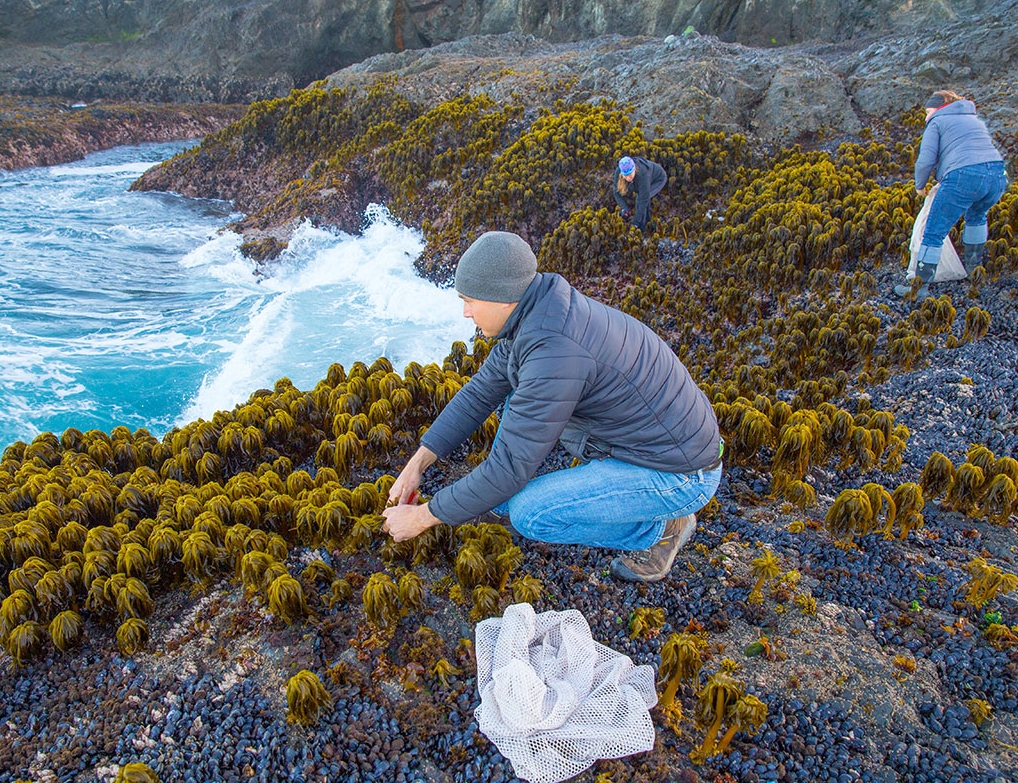Seaweed: The Ocean’s Gift

by Holly Madrigal | photos by Ree Slocum
“Before we start we thank the ocean for this gift,” says Terry d’Selkie as her voice raises to sing a song taught to her from an elder. The song has calls that sound like seabirds and gives our thanks for the seaweed harvest we are about to collect.
Today is a nice low tide so the ocean ebbs and flows calmly as we clamber over rocks gathering sweet kombu, wakame, and sea palm. Sweet kombu grows in bunches on these rocks, and we navigate the sea anemones and urchins to cut the broad leaves; my hands become somewhat slimy. d’Selkie explains that this seaweed has lots of saccharides, which account for its sweetness. The Mendocino Coast kombu grows in long smooth ribbons and can be used when soaking and cooking dried beans. Enzymes in the seaweed help break down the properties of beans that can lead to digestive issues, like gas. Kombu is also proven to eliminate heavy metals and radiation from the body.
I learn a lot as we harvest. The wakame is broad and emerald; Terry calls this “women’s seaweed” because it is so rich in calcium and other nutrients. When it comes to the sea palm, Terry instructs us to cut the smaller palm fronds leaving a two-inch mop atop the stalk. This allows the palm to continue to grow and multiply.
We trim the seaweed in bunches and fill mesh bags to be hauled back up the rocks. Terry takes an “accept what nature gives you” approach with her seaweed harvesting business, Ocean Harvest Sea Vegetable Company. She does not freshwater rinse, since doing so dilutes the minerals and flavor, and instead rinses the seaweed in the ocean. The harvested seaweed is sun-dried in the fresh air of the Mendocino mountains.
To ensure the safety of her product, Terry takes the seaweed to a lab to test for radiation (we are across the sea from Fukushima) as well as toxins or other impurities. Every time the results have come back clean.
Ocean Harvest sells their sea vegetables at many local markets. Terry has customers in Colorado and New York as well as some local restaurants. Café 1, in Fort Bragg, uses the sea palm in their coleslaw.
Any individual can harvest ten pounds without a permit, although the sea palm requires authorization. I, for one, am delighted and humbled by this bounty that awaits us just off shore. No need to board a kayak or don a wetsuit to gather these nutritional powerhouses; a song of gratitude instead seems very fitting for this gift.
Recipe: SPICY SEA PALM SALAD
Serves 6-8
1/2 to 1 oz. Sea Palm (crumbled)
8 oz. spaghetti or soba noodles (broken in half)
2-3 Tbsp. hot pepper sesame oil
2-3 Tbsp. sesame oil or olive oil
2-3 Tbsp. shoyu or tamari sauce
1-2 Tbsp. maple syrup or natural sweetener
2-3 Tbsp. vinegar
2 cloves garlic (minced)
2 Tbsp. ginger (grated)
1/2 cup cilantro (chopped)
1/2 cup roasted pepitas (toasted pumpkin seeds)
Cook noodles according to directions. Add Sea Palm during the last 5 minutes of cooking—crumbled sea palm will expand, so smaller pieces are better.
Meanwhile, mix all liquid ingredients, garlic and ginger in a large bowl. Drain and rinse noodles and sea palm. Add to large bowl. Mix well. Just before serving, add cilantro and pumpkin seeds. Enjoy hot or cold!!


